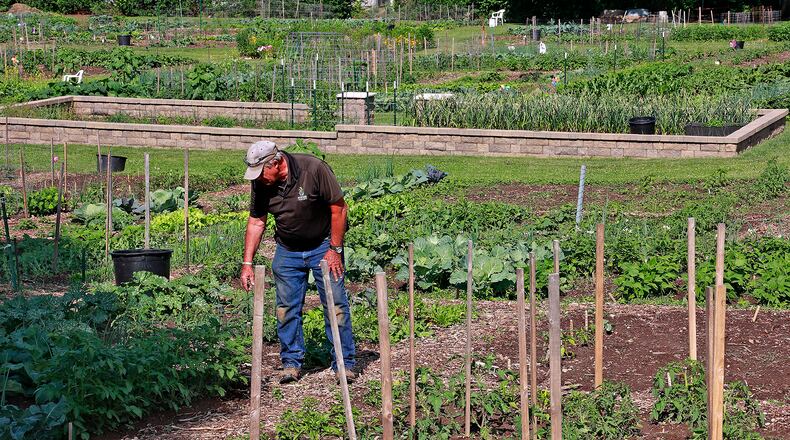Driven by the modern food movement, the garden was founded in 2010 by Terry Fredrich, Mary Crabtree and Sherry Chen and has continued to grow.
As a conventional agriculture renegade, Fredrich learned his knowledge of small-scale, local food production from South America along with his wife and uses that knowledge at the garden.
“This is really the ground level teaching of agriculture and how to feed yourself, or at least improve your diet,” said Fredrich. “It’s answering the question ‘What am I feeding my children and where did it come from?’”
The garden, which currently has a waitlist, has 85 plots belonging to different individuals, pairs or families. It’s all organic and uses compost for nutrients.
“When you grow organically, you can’t just say, ‘Well I’ve got this warm and fuzzy feeling that I want to do things without fertilizers or pesticides.’ You have to say, ‘how do I do this, how am I going to control insects, how am I going to control diseases, where are they getting nutrients from?” said Fredrich.
They educate people on how to control certain pests and diseases botanically, not chemically like most farms and gardens.
“Key thing is it improves brain power eating that dirt,” he joked as he brushed off a freshly picked radish.
Knowledge is key
Education is an important aspect to the garden. They have classes available where they teach how to can food, food storage, cooking, using herbs, and even an entire class about garlic: how to grow it, store it, cook with it, and harvest it.
“It’s very satisfying to plant a seed, and to watch it grow, and to take it home and cook a dish. It’s very full circle,” said Rose Cox, who has been gardening for about 12 years. “You know where it came from; it didn’t have any chemicals on it. It’s a sense of accomplishment.”
Credit: Bill Lackey
Credit: Bill Lackey
Taking a walk around the property, Fredrich pointed out cabbage, lettuce, Brussel sprouts, broccoli, cucumbers, watermelon, radishes, tomatoes and more, all being grown by the gardeners. Around 70 percent of the gardeners are from the south side of Springfield — beneficial to many who are affected by the city’s food desert — and it provides accessible and affordable nutrient-rich foods rather than just empty calories.
Although food grown from the garden isn’t sold, some gardeners give their produce to family and friends, and others donate to senior living communities, soup kitchens and food banks.
“I like to give out what I grow to my friends, my family, my neighbors,” said Mackenzie Rice, a first-year gardener at Jefferson Street Oasis. “It brings me joy that I can share with other people.”
Credit: Bill Lackey
Credit: Bill Lackey
Eggs are offered
Not only does the property have a garden, but other structures include a children’s cottage, a poly house (a smaller type of green house), and a chicken coup.
The chickens are owned by a southside resident, Cheryl Fitzgerald, but the garden provides the pasture, buildings, supplies and feed while the owner cares for them. The eggs are then given to the gardeners on a rotation at no cost. They’re fresh, organic and delicious, and they aren’t anything like the eggs you buy in store, said Fredrick and Kris Kolbinski, the garden’s treasurer.
The eggs aren’t washed, so they still have their natural anti-bacterial coat on, which means they don’t have to be refrigerated and last longer than store-bought eggs.
Fredrich was raised on a farm in northern Ohio and went on to get an agricultural degree. There are certain things that universities or commercial jobs can’t teach you, so he takes pride in teaching people how to grow their own local and organic food.
“I really do get a high off helping people who have never done it before. And to see their face when they start harvesting is just unbelievable,” said Fredrich.
“Eight plants, 764 tomatoes as big as your fist,” said gardener Gene Barnett after listening to Fredrich’s advice on not planting seeds too close together, “and that’s factual, because I counted.”
Kolbinski, who has been gardening there for three years, said her favorite part about this garden is “the comradery when you’re out here, fresh air, nice people, everybody helps everybody.”
Not only do they grow fruits and vegetables, but this garden grows volunteer opportunities and community pride and spirit.
This all-volunteer garden gets its funding from small local grants, churches and private individuals. One big fundraising event they have is their annual “Grilling in the Garden” on July 29 from 10 a.m.-4 p.m. where they grill corn, other vegetables and veggie pizza, all free and open to the public.
“People cannot believe you can fix vegetables in so many different ways that taste good, and that day proves it,” said Fredrich.
To volunteer at the Jefferson Street Oasis, or for information on classes or to join the waitlist, go to their Facebook page, or contact them by email habitatcreatohio@aol.com.
Donations can be made mailed to Jefferson Street Oasis, P.O. Box 2812 Springfield, OH.
About the Author


